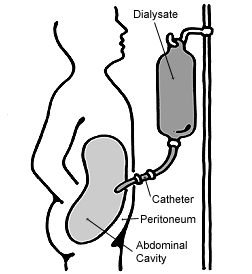| Peritoneal dialysis | |
|---|---|
 Diagram of peritoneal dialysis | |
| Specialty | nephrology |
| ICD-9-CM | 54.98 |
| MeSH | D010530 |
Peritoneal dialysis (PD) is a type of dialysis that uses the peritoneum in a person's abdomen as the membrane through which fluid and dissolved substances are exchanged with the blood.[1][2] It is used to remove excess fluid, correct electrolyte problems, and remove toxins in those with kidney failure.[3] Peritoneal dialysis has better outcomes than hemodialysis during the first two years.[4] Other benefits include greater flexibility and better tolerability in those with significant heart disease.[4]
- ^ Perl J, Bargman JM (2016-11-01). "Peritoneal dialysis: from bench to bedside and bedside to bench". American Journal of Physiology. Renal Physiology. 311 (5): F999–F1004. doi:10.1152/ajprenal.00012.2016. ISSN 1931-857X. PMID 27009336.
- ^ Billings DM (2008-11-01). Lippincott's Content Review for NCLEX-RN. Lippincott Williams & Wilkins. p. 575. ISBN 978-1-58255-515-7. Archived from the original on 2017-01-13.
- ^ Cite error: The named reference
WHO2008was invoked but never defined (see the help page). - ^ a b Cite error: The named reference
Lim_2016was invoked but never defined (see the help page).